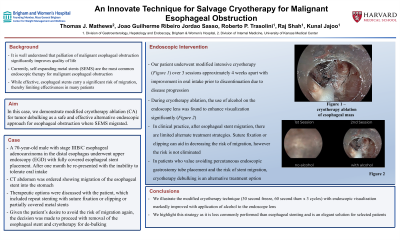Monday Poster Session
Category: Endoscopy Video Forum
P1795 - Salvage Cryotherapy for Malignant Esophageal Obstruction

- TM
Thomas J. Mathews, MD
University of Kansas Medical Center
Kansas City, MO
Presenting Author(s)
1University of Kansas Medical Center, Kansas City, MO; 2Brigham and Women's Hospital, Boston, MA; 3Brigham and Women's Hospital, Boston, MA; 4Hospital das Clínicas da Faculdade de Medicina da Universidade de São Paulo, Castelo, Espirito Santo, Brazil
Introduction: Palliation of malignant esophageal obstruction significantly improves quality of life. Self-expanding metal stents (SEMS) are the most common endoscopic therapy for malignant esophageal obstruction. While effective, esophageal stents carry a significant risk of migration, thereby limiting effectiveness for some patients. In this case, we demonstrate modified cryotherapy ablation (CA) for tumor debulking as a safe and effective alternative endoscopic approach for esophageal obstruction where SEMS migrated.
Case Description/Methods:
A 70-year-old male with stage IIIB/C esophageal adenocarcinoma in the distal esophagus underwent upper endoscopy (EGD) with fully covered esophageal stent placement. After one month he re-presented with the inability to tolerate oral intake. CT abdomen showed migration of the esophageal stent into the stomach. Therapeutic options including repeat stenting with suture fixation or clipping or partially covered metal stents were offered. Given the desire to avoid the risk of migration again, the decision was made to proceed with removal of the esophageal stent and cryotherapy for de-bulking. Patient underwent modified intensive cryotherapy (Video) over 3 sessions approximately 4 weeks apart with improvement in oral intake prior to discontinuation due to disease progression. During cryotherapy ablation, the use of alcohol on the endoscope lens was found to enhance visualization significantly.
Discussion:
In clinical practice, after esophageal stent migration, there are limited alternate treatment strategies. Suture fixation or clipping can aid in decreasing the risk of migration, however the risk is not eliminated. In patients who value avoiding percutaneous endoscopic gastrostomy tube placement and the risk of stent migration, cryotherapy debulking is an alternative treatment option. We illustrate the modified cryotherapy technique (30 second freeze, 60 second thaw x 3 cycles) with endoscopic visualization markedly improved with application of alcohol to the endoscope lens. We highlight this strategy as it is less commonly performed than esophageal stenting and is an elegant solution for selected patients.

2. Comparison of endoscopic viewing with use of alcohol to lens
Disclosures:
Thomas J.. Mathews, MD1, Roberto P.. Trasolini, MD, MSc2, Raj Shah, MD3, João Guilherme Ribeiro Jordão Sasso, MD4, Kunal Jajoo, MD2. P1795 - Salvage Cryotherapy for Malignant Esophageal Obstruction, ACG 2023 Annual Scientific Meeting Abstracts. Vancouver, BC, Canada: American College of Gastroenterology.

